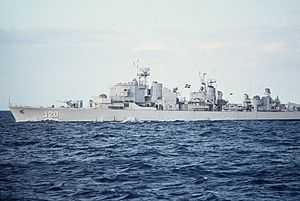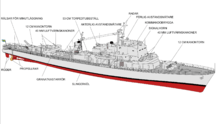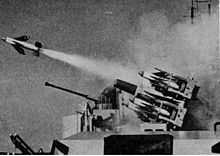Östergötland-class destroyer
 HMS Östergötland | |
| Class overview | |
|---|---|
| Builders: | Götaverken, Eriksbergs Mekaniska Verkstad, Kockums Mekaniska Verkstads AB |
| Operators: | Swedish Navy |
| Preceded by: | Halland class destroyer |
| Succeeded by: | None to date (As of March 2015) |
| In commission: | Sweden: 1958–1982 |
| Completed: | 4 |
| Retired: | 4 |
| Preserved: | 0 |
| General characteristics (Sweden)[1] | |
| Displacement: | 2,150 tons standard 2,600 tons full load |
| Length: | 112 m (367 ft 5 in) |
| Beam: | 11.2 m (36 ft 9 in) |
| Draft: | 3.7 m (12 ft 2 in) |
| Propulsion: | 2 shaft geared turbines, 2 boilers, 47,000 hp (35,000 kW) |
| Speed: | 35 kn (65 km/h) |
| Range: | 3,000 nmi (6,000 km) at 20 knots (37 km/h) |
| Complement: | 244 |
| Armament: | 4 × 120 mm (4.7 in) guns (2×2) 7 × Bofors 40 mm AA guns (7×1) 6 × 533 mm (21.0 in) torpedo tubes (1×6 ) for Wire-guided Torped 61 1 Squid anti-submarine mortar 1 quadruple Seacat SAM launcher replaced 3 - 40mm guns in 1960's |
| Notes: | Ships of the class took part in a number of incidents and confrontations involving Soviet incursions into Swedish waters during the late 1970s and early 1980s, most notably the Whiskey on the rocks incident in 1981. |
The Östergötland class were a group of destroyers built for the Swedish Navy in the late 1950s. They were smaller and less capable than the preceding Halland class destroyers and were decommissioned in 1982. The class was to be the last destroyers to be built by Sweden in the 20th Century. They were sometimes referred to as Light destroyers.
Ships
| ship | Pennant number | builder | commissioned | fate |
|---|---|---|---|---|
| HMS Östergötland | J20 | Götaverken, Göteborg | 1958 | Decommissioned 1982, |
| HMS Södermanland | J21 | Eriksberg, Göteborg[lower-alpha 1] | 1958 | Decommissioned 1982 |
| HMS Gästrikland | J22 | Götaverken, Göteborg | 1959 | Decommissioned 1982 |
| HMS Hälsingland | J22 | Eriksberg, Göteborg | 1959 | Decommissioned 1982 |

The general layout of an Östergötland destroyer, prior to the class being modernised between 1963 and 1967
Notes
- ↑ In the case of the Södermanland, unlike her sister ship Hälsingland, Eriksbergs Mekaniska Verkstad just built the hull, with completion and fitting out done by Kockums Mekaniska Verkstads AB. The reasons for this are unclear, though it may possibly have been part of a work share agreement.
References
- ↑ Conway's All the World's Fighting Ships 1947-1995
- ↑ "SEACAT - The Guided Missile To Defend Small Ships" FLIGHT International, 5 September 1963, p. 442.
- Gardiner, Robert and Stephen Chumbley. Conway's All The World's Fighting Ships 1947–1995. Annapolis, Maryland, USA, 1995. ISBN 1-55750-132-7.
| ||||||||||
